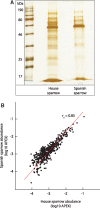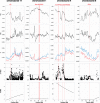Molecular Diversification of the Seminal Fluid Proteome in a Recently Diverged Passerine Species Pair
- PMID: 31665510
- PMCID: PMC6993853
- DOI: 10.1093/molbev/msz235
Molecular Diversification of the Seminal Fluid Proteome in a Recently Diverged Passerine Species Pair
Abstract
Seminal fluid proteins (SFPs) mediate an array of postmating reproductive processes that influence fertilization and fertility. As such, it is widely held that SFPs may contribute to postmating, prezygotic reproductive barriers between closely related taxa. We investigated seminal fluid (SF) diversification in a recently diverged passerine species pair (Passer domesticus and Passer hispaniolensis) using a combination of proteomic and comparative evolutionary genomic approaches. First, we characterized and compared the SF proteome of the two species, revealing consistencies with known aspects of SFP biology and function in other taxa, including the presence and diversification of proteins involved in immunity and sperm maturation. Second, using whole-genome resequencing data, we assessed patterns of genomic differentiation between house and Spanish sparrows. These analyses detected divergent selection on immunity-related SF genes and positive selective sweeps in regions containing a number of SF genes that also exhibited protein abundance diversification between species. Finally, we analyzed the molecular evolution of SFPs across 11 passerine species and found a significantly higher rate of positive selection in SFPs compared with the rest of the genome, as well as significant enrichments for functional pathways related to immunity in the set of positively selected SF genes. Our results suggest that selection on immunity pathways is an important determinant of passerine SF composition and evolution. Assessing the role of immunity genes in speciation in other recently diverged taxa should be prioritized given the potential role for immunity-related proteins in reproductive incompatibilities in Passer sparrows.
Keywords: cryptic female choice; fertility; immunity; positive selection; reproduction; selective sweep; sperm competition.
© The Author(s) 2019. Published by Oxford University Press on behalf of the Society for Molecular Biology and Evolution.
Figures





Similar articles
-
The Seminal fluid proteome of the polyandrous Red junglefowl offers insights into the molecular basis of fertility, reproductive ageing and domestication.Sci Rep. 2016 Nov 2;6:35864. doi: 10.1038/srep35864. Sci Rep. 2016. PMID: 27804984 Free PMC article.
-
Identification and characterization of the zebra finch (Taeniopygia guttata) sperm proteome.J Proteomics. 2019 Feb 20;193:192-204. doi: 10.1016/j.jprot.2018.10.009. Epub 2018 Oct 23. J Proteomics. 2019. PMID: 30366121
-
Within-species divergence in the seminal fluid proteome and its effect on male and female reproduction in a beetle.BMC Evol Biol. 2015 Dec 2;15:266. doi: 10.1186/s12862-015-0547-2. BMC Evol Biol. 2015. PMID: 26627998 Free PMC article.
-
Proteomics of reproductive systems: Towards a molecular understanding of postmating, prezygotic reproductive barriers.J Proteomics. 2016 Mar 1;135:26-37. doi: 10.1016/j.jprot.2015.10.015. Epub 2015 Oct 23. J Proteomics. 2016. PMID: 26476146 Review.
-
Proteomic discovery of diverse immunity molecules in mammalian spermatozoa.Syst Biol Reprod Med. 2012 Aug;58(4):218-28. doi: 10.3109/19396368.2012.700442. Syst Biol Reprod Med. 2012. PMID: 22788534 Review.
Cited by
-
Three decades of sperm competition in birds.Philos Trans R Soc Lond B Biol Sci. 2020 Dec 7;375(1813):20200208. doi: 10.1098/rstb.2020.0208. Epub 2020 Oct 19. Philos Trans R Soc Lond B Biol Sci. 2020. PMID: 33070724 Free PMC article. Review.
-
Biofluids manipulation methods for liquid biopsy in minimally-invasive assays.MethodsX. 2022 Jun 17;9:101759. doi: 10.1016/j.mex.2022.101759. eCollection 2022. MethodsX. 2022. PMID: 35774416 Free PMC article.
-
Indel driven rapid evolution of core nuclear pore protein gene promoters.Sci Rep. 2023 May 17;13(1):8035. doi: 10.1038/s41598-023-34985-0. Sci Rep. 2023. PMID: 37198214 Free PMC article.
-
Extensive transgressive gene expression in testis but not ovary in the homoploid hybrid Italian sparrow.Mol Ecol. 2022 Aug;31(15):4067-4077. doi: 10.1111/mec.16572. Epub 2022 Jul 4. Mol Ecol. 2022. PMID: 35726533 Free PMC article.
-
A predominant role of genotypic variation in both expression of sperm competition genes and paternity success in Drosophila melanogaster.Proc Biol Sci. 2023 Sep 27;290(2007):20231715. doi: 10.1098/rspb.2023.1715. Epub 2023 Sep 20. Proc Biol Sci. 2023. PMID: 37727083 Free PMC article.
References
-
- Ait Belkacem A, Gast O, Stuckas H, Canal D, LoValvo M, Giacalone G, Päckert M.. 2016. North African hybrid sparrows (Passer domesticus, P. hispaniolensis) back from oblivion—ecological segregation and asymmetric mitochondrial introgression between parental species. Ecol Evol. 6(15):5190–5206. - PMC - PubMed
Publication types
MeSH terms
Substances
Grants and funding
LinkOut - more resources
Full Text Sources
Research Materials

